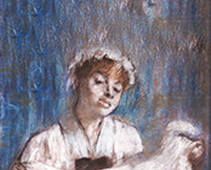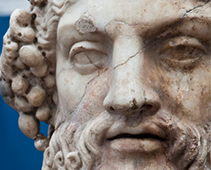Opening Hours
Tuesday - Sunday 11 a.m. - 5 p.m.
Closed on Mondays
Closed on the following days:
January 1st, June 5th, December 24th & 25th.
TRACKING COLOUR
Greek and Roman marble statues were not set up in blazing white. They were colourful. We are now on the track of the colours that remain on sculptures in our collection.
The research project now under way in the Glyptotek is the first of its kind. The aim is to identify, document and study traces of colour on our Greek and Roman sculptures.
ANCIENT SCULPTURE WAS COLOURFUL
Ancient written sources, as well as the evidence found on the works themselves, show that Greek and Roman sculptures were colourful. They were ‘polychrome’, ‘many-coloured’.
Works in stone were painted and sculptures in bronze stood in the colour of the metal, with details such as eyes, lips and teeth added in other coloured materials: ivory, copper, amber and silver among them. Statues were also made in silver, gold and ivory. And in Roman Imperial times, sculptors began using coloured marbles. During recent years, research on the polychromy of ancient sculpture has increased. But our knowledge is still very limited.
THE GLYPTOTEK PROJECT AND THE COPENHAGEN POLYCHROMY NETWORK
Ancient sculptural polychromy in the Ny Carlsberg Glyptotek’ is a project designed to systematically investigate our Greek and Roman stone sculptures for traces of colour. It is the first of its kind anywhere.
In-depth examination and understanding of colour traces require an interdisciplinary approach. Collaboration has therefore been established between the Glyptotek, the School of Conservation of the Academy of Fine Arts, the Institute of Chemistry at the Technical University of Denmark and the Museum of Geology/The Natural History Museum of Denmark. We call this partnership ‘The Copenhagen Polychromy Network’.
HOW ARE THE COLOURS PRESERVED?
It is astounding that any traces of colour are to be found on sculptures that are a couple of thousand years old.
DIRECT PRESERVATION
The preservation of traces of the original painting on an ancient stone sculpture may be either direct or indirect. In some cases remains of the colours themselves are directly preserved. Such colour traces are visible to the naked eye, or they are revealed under microscopy.
INDIRECT PRESERVATION
‘Colour shadows’ Where pigments were worn away quickly, the stone surface was exposed to weathering for a longer time. They therefore appear darker than surfaces covered by more durable pigments. The latter surfaces appear lighter. This difference in the colour of the stone surface is called ‘colour shadows’. They reveal where paint was once applied, even though the pigments have disappeared.
WEATHERING RELIEFS
Difference in pigment durability may result in the less well-protected surfaces being worn down to a lower level than those protected for a longer time by durable pigments. This leads to a ‘weathering relief’, visible under raking light. This tells us where paint was once applied.
INCISIONS
In Archaic and early Classical Greek sculpture (c. 600-460 BC), the contours of motifs were often incised to guide the painter. They become visible under raking light.
ULTRAVIOLET AND INFRARED FLUORESCENT PHOTOGRAPHY
Organic materials were used as binding media in pigments and as colouring agents. Infrared and ultraviolet light can activate remains of organic material on the stone. They fluoresce and thus reveal where paint was originally found.
HOW DO WE FIND THE COLOURS?
A whole range of methods are employed to track down the colours, from careful observation with the naked eye to the use of electron microscopy. Conservation science and natural science play a decisive role.
VISUAL EXAMINATION
The sculpture is examined with the naked eye, binocular magnifier and binocular microscope. It is also photographed in controlled normal light, as well as in infrared and ultraviolet light to reveal remains of organic substances which may originate from ancient pigments..
When traces of pigment are located, they are studied using a Leica DM651 operation microscope with up to 100x magnification. Digital photography is used to document this process.
Depending on the amount of pigment preserved, samples may be taken. The sample size is minute, about 0.3 cubic millimetres. Cross-sections of the samples provide information on the paint layer structure and the pigments employed. Study of the cross-sections is conducted by the museum using a dark field microscope.
CONSERVATION AND NATURAL SCIENTIFIC ANALYSIS
In-depth examination of especially promising samples is carried out by our external network partners in conservation science and natural science. They have at their disposal a range of sophisticated technologies. These include scanning electron microscopy with X-ray, Fourier transform infra-red spectroscopy, Raman laser spectroscopy and inductive plasma mass spectroscopy.
WHAT WERE THE COLOURS MADE OF?
We are used to buying paint ready for use. Not so the Greeks and Romans. Pigments had to be produced from the ground up, using natural colouring agents. Most were inorganic, some organic.
We know about ancient pigments from the written sources, in particular the ‘Natural History’ by Plinius the Elder, a Roman author of the 1st century AD. To this we may add the results achieved by polychromy research in recent times.
The pigments were mainly inorganic, made from minerals or natural earth colours. We also know of organic pigments extracted from plants and two kinds of synthetic pigments are also found.
Of the pigments known, some of the most important are:
• Cinnabar, mercuric sulphide, was a popular, expensive red mineral pigment.
• Ochre, an earth colour containing iron oxide, is found in hues from orange to reddish brown.
• Red lead, lead tetroxide, is also known as ‘minium’ and is of course red.
• Madder lake, or alizarin, is a pinkish red organic pigment from the root of the madder plant.
• Orpiment and realgar are both arsenic sulphide minerals used to produce yellow pigments.
• Azurite is a copper mineral and the source of a deep blue. It can turn into a greenish hue through weathering to malachite.
• Egyptian blue is the oldest known synthetic pigment, made from calcium, silicium and copper.
• Malachite, a green copper carbonate mineral closely related to azurite – and just as expensive.
• Bone black and vine black are organic pigments resulting from carbonization.
• Lead white, a lead carbonate, is a synthetically produced white pigment.




